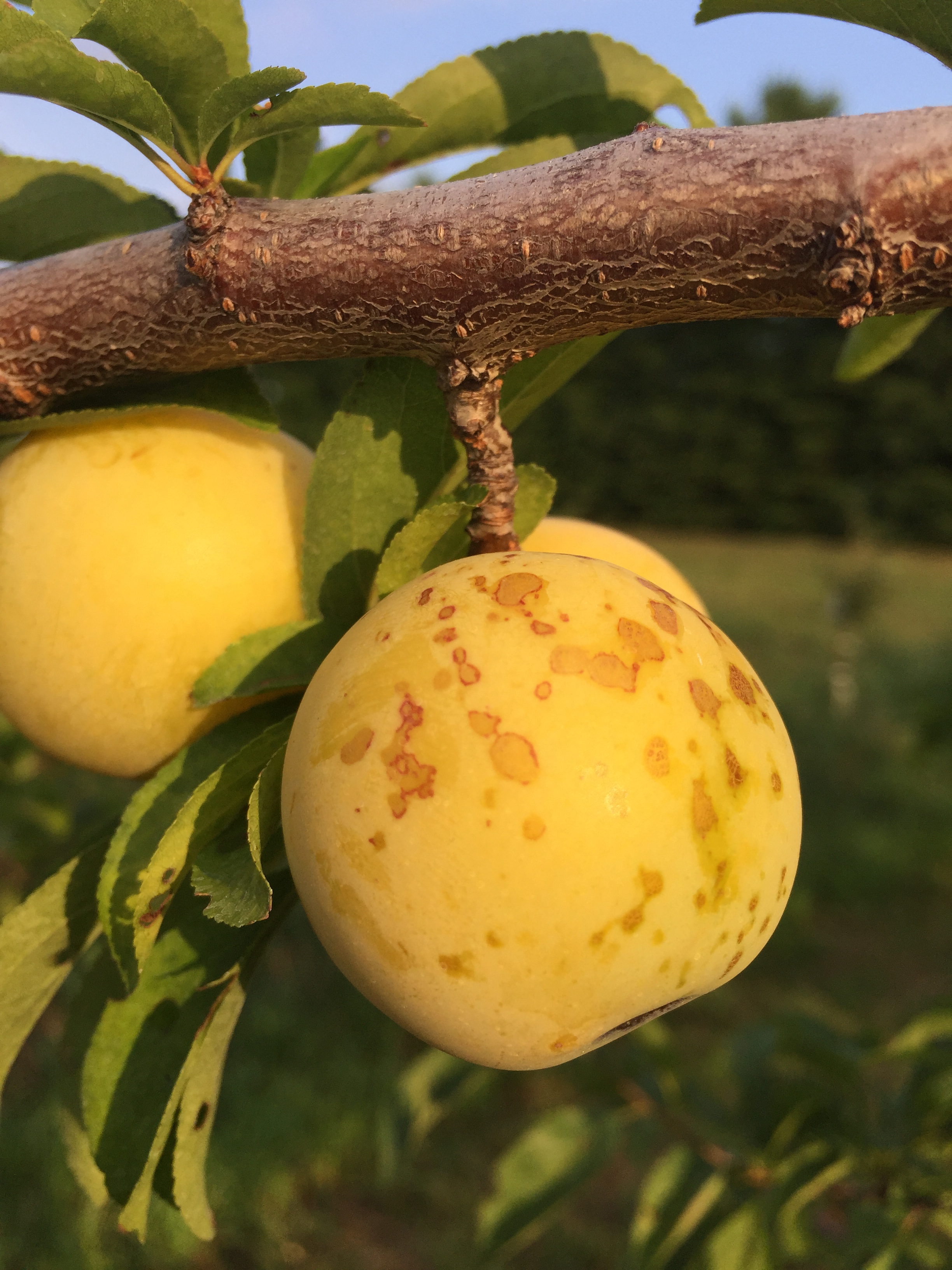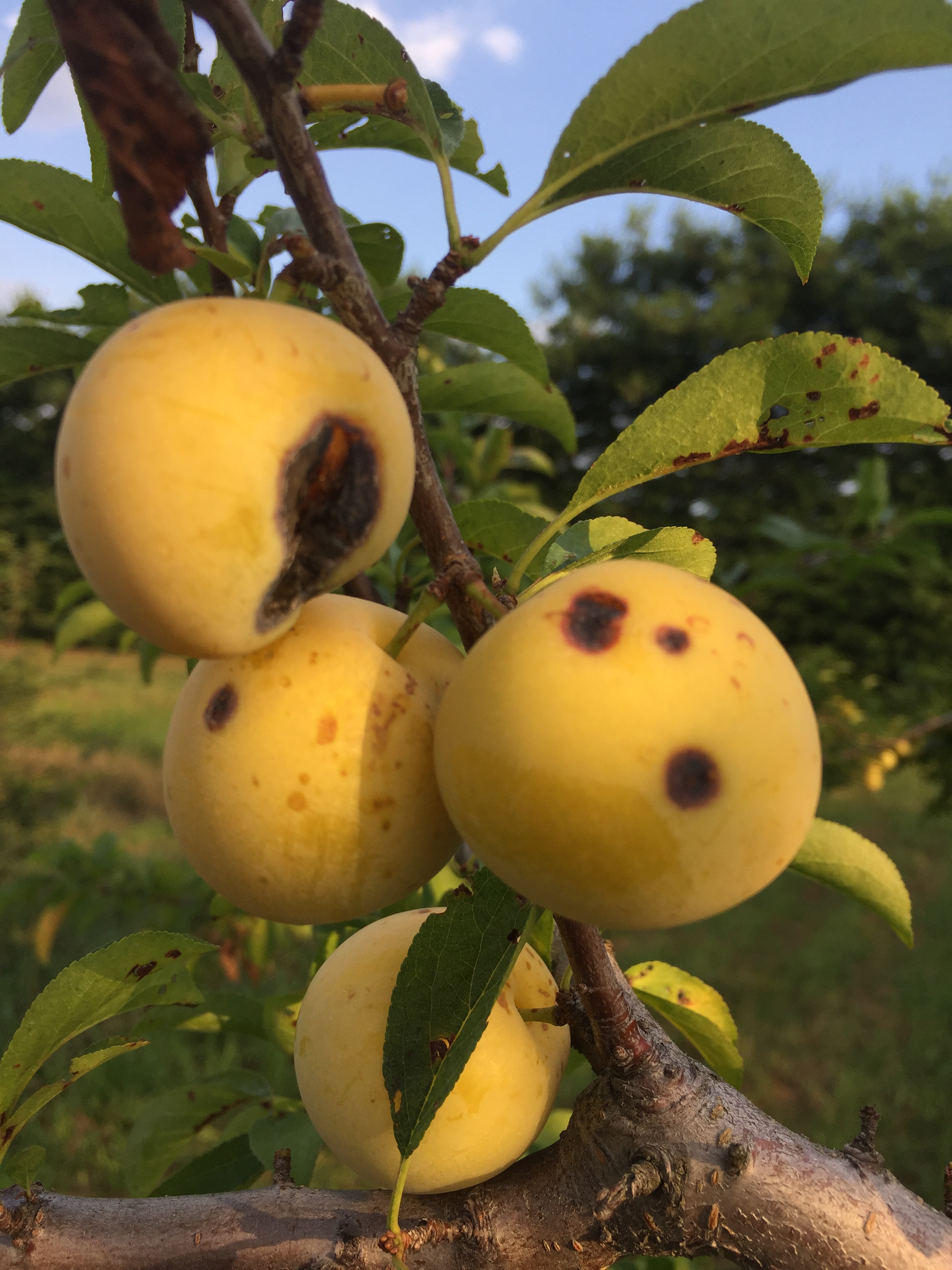Southwest Michigan fruit update – July 30, 2018
A cool dry week allows harvests to move quickly. Expect an increase in insect activity. Summer fruit harvest continues.
Weather
Last week temperatures were cooler with highs in the upper 70s. Scattered showers crossed the region during the week dropping light rain in widely scattered areas. Rain fall totals ranged from zero to over a half inch with an average of 0.25 inches. Highs this week will higher, above 80 with lows in the 60s. There is chance of thunderstorms most of the week. Dry conditions in July have reduced plant disease activity. Our heat accumulation is about 7 to 10 days ahead of normal.
Southwest Michigan GDD Summary from March 1 through July 29, 2018
|
Station |
GDD 42 F |
GDD 45 F |
GDD 50 F |
|
Benton Harbor (SWMRC) |
2519 |
2210 |
1724 |
|
Lawton (Lawton) |
2546 |
2236 |
1746 |
|
Fennville (TNRC) |
2385 |
2085 |
1614 |
|
Average for the SW region |
2529 |
2216 |
1729 |
|
Accumulation last week |
196 |
166 |
131 |
Tree fruit
San Jose scale has become a problem for many stone fruit growers, who often do not use oil sprays in the late dormant season. These growers are focusing controls on the crawler stage during the summer. San Jose scale male trap catches for the second generation continue to climb according to the Trevor Nichols trapline in Fennville. Crawlers should start emerging around August 5, approximately 300 to 350 degree days base 50 F after the start of the flight (July 23). Females can produce young for many weeks which makes it difficult to control with only one spray. Brown Marmorated Stink Bug (BMSB) adults are still rare, but numbers will increase over the next month.
Apricot harvest has ended.
Peaches and nectarines harvested over the past week included Summer Serenade, Garnet Beauty, and for some sites Redhaven, PF9A-007, and PF14NJ. Brown rot is showing up in orchards with fruit damaged by insects. Fungicide treatments for brown rot are needed as fruit background color loses its green color. Leaf drop of older leaves due to early season bacterial spot infection is common on susceptible varieties. Oriental fruit moth numbers declined in most orchards indicating the second generation flight is ending. We are still catching good numbers of this pest at some sites. Oriental fruit moth can still be a problem in young peach trees by injuring shoot tips of developing scaffolds.
Cherry harvest is over. In tart cherries, defoliation caused by cherry leaf spot is common. After harvest, growers should apply a long lasting protectant fungicide to preserve the remaining leaves. Modest pruning of mature tart and sweet cherries can be done up to early September.
In plums, the harvest of Japanese plums continues with Shiro, Vibrant, Vanette and Santa Rosa. Bacterial spot symptoms on fruit due to infection early in the season are common on some varieties. Ripening fruit should be protected against apple maggot. Apple maggot trap numbers increased for the third straight week at the Trevor Nichols Research Center. Codling moth and oriental fruit moth can also attack plums. Spotted wing Drosophila (SWD) can attack plums as they ripened, with their thin skins and soft flesh. Plums become susceptible when they soften to approximately 3 lb. firmness, measured without skin. Use a fruit firmness gauge fitted with a pear tip. Brown rot is also a threat as fruit ripens.

.jpg)
Two examples of spray phytotoxicity (top, left) marking on Shiro plum caused by ziram fungicide. Photo by Bill Shane, MSU Extension. Note the pattern of droplets on the fruit. (bottom, right) leaf spotting caused by a spray in blueberries. Note the damage at the leaf edge where drying would concentrate spray materials and the lack of damage to the fruit. Photo by Mark Longstroth, MSU Extension.
In Apples, catches of both oriental fruit moth and codling moth adults continue at relatively low levels in some orchards. Oblique banded leaf roller summer generation larvae have been active and we are seeing the start of the second generation flight in some orchards. Apple maggot numbers have risen sharply the last three weeks. We expect a large number of mature flies in many orchards. Growers should be sure that their insecticide choices include materials effective against apple maggot. Growers should include fungicides for sooty blotch and fly speck in their cover sprays.
Pears become attractive to codling moth attack when they soften close to harvest in August.
Bacterial spot lesions on Shiro plum caused a bacterial spot infection early in the season. Photo by Bill Shane, MSU Extension.
Small fruit
Grapes are at cluster tightening. Veraison in early varieties should begin soon. The hot dry weather has slowed diseases. Concord and Niagara berries are now resistant to black rot fruit infection. Vinifera and hybrid grapes fruit should be protected for another few weeks until veraison. Growers should scout for powdery mildew and downy mildew on the leaves. There are new downy lesions on leaves of susceptible varieties, but not much else.
The second grape berry moth flight is ending and we are seeing some stings in vineyards. The Enviroweather grape berry moth model predicts the start of egg laying for the third generation of grape berry moth will begin this week (July 30 in Scottdale; July 31 in Lawton, Baroda and Berrien Springs; Aug. 1 in Benton Harbor and Aug. 4 in Fennville). Typicalfor this time of year, only a few moths are being trapped. If cooler weather continues, it will slow development of the third generation larvae. This will prolong the risk period from this brood. Growers need to check vineyards and consider whether to take additional action to control the third generation around the end of August. Because egg laying in early August occurs when day lengths are longer than 14 hours, we expect a partial fourth grape berry moth generation in southwest Michigan. We can still find a few Japanese beetles in vineyards. Wine grape growers who manage a small canopy, should check for beetle presence and leaf damage and decide if control is necessary. Brown marmorated stink bug nymphs, grape and potato leafhopper are scarce. The number of SWD flies in traps has increased over the past few weeks, but until the grapes reach veraison, no treatment is needed for this pest.
Blueberry harvest continues. Both hand and mechanical harvest of Bluecrop, Jersey and other mid-season varieties is moving quickly. Fruit quality has been generally very good with some anthracnose and alternaria. Cane collapse from phomopsis is relatively scarce. Yields are variable and small fruit due to poor pollination is a problem in some areas. Growers are applying fungicides and insecticides to protect ripening fruit against fruit rots and spotted wing drosophila (SWD). SWD numbers continue to rise. With cooler weather numbers will build quickly. Most traps outside sprayed fields are in the double digits. With the drier weather, growers should maintain their irrigation. During the summer, blueberry fields need an inch of water every 3 or 4 days.
.jpg)
A heavy crop of berries on Ruble. Ruble is a selection from wild highbush blueberries from New Jersey. Ruble was one of the first named blueberry varieties released in 1911. There are still over a thousand acres of ruble in Michigan the fruit is small but sweet. Photo by Mark Longstroth, MSU Extension.
Strawberries are making good growth after renovation. Growers should irrigate to maintain good soil moisture promoting good strong growth. As new leaves emerge they should be protected from potato leafhopper, which stunts strawberry growth.
Bramble harvest continues. Red summer raspberry harvest is winding down and blackberry harvest is ramping up. Raspberries and blackberries are a preferred host for SWD and the fruit needs to be protected. Japanese beetles are out. Target Japanese beetle as soon as you see it to prevent this pest from aggregating in your fields.
Upcoming Meetings
- There is a Michigan Grape Society Grower Social on Wednesday, August 8 at 4 p.m. hosted by Mike Deshaaf at 1936 Meadowbrook Farm. This meeting is and will focus on vineyard floor management and crop adjustment. It will include a tour of Mike’s herbicide free vineyard and include:
- Discussion of cover crop options by Dean Baas, MSUE Cover Crop Educator
- Fall cover crop plans by Mike DeShaaf
- Crop Adjustment by Mark Longstroth, MSUE Small Fruit Educator
- Jesus Units by Mike Moyer, Vine and Viticulture Director at Lake Michigan College.
- Following the vineyard tour there will be a pig roast and wine tasting. The cost of the meeting is $25. RSVP by August 6 to Mike Deshaaf at 269.326.0430. 1936 Meadowbrook Farm is located at 4352 Meadowbrook Road, Benton Harbor, MI
- The Annual Trevor Nichols Research Center Field Day is Tuesday, September 25, 2018 from 1 to 4 PM at the Trevor Nichols Research Complex west of Fennville.
Related Articles:
Michigan State University Spotted Wing Drosophila website
Southwest Michigan Fruit Update July 24, 2018
Post-harvest cherry leaf spot applications
Monitoring and management strategies for apple maggot in 2010
Using the MSU Enviroweather grape berry moth model in 2018



 Print
Print Email
Email



